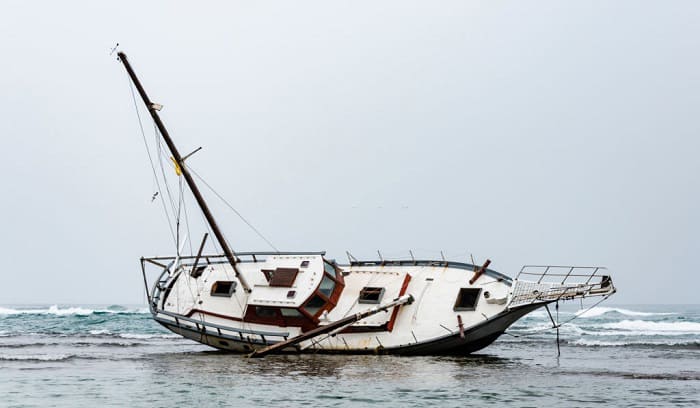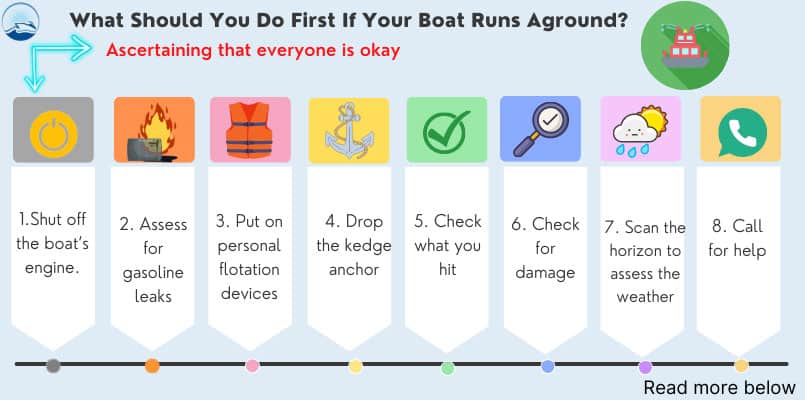Do you know anyone who ran his watercraft aground and worsened the situation by not managing it properly? Many first-time vessel owners ask, what should you do first if your boat runs aground?
I understand their line of thinking. It is easy to hit the panic button, especially if it is your first time piloting a watercraft. One wrong move and you can injure your passengers or damage your vessel beyond repair.
Thus, do not panic because this article will help you manage such a situation, get everyone else safely on land, and avert costly boat disasters.
First, you must ensure your passenger’s safety. Second, turn off the engine and quickly assess for signs of fuel leaks. Third, put on PFDs and anchor your boat. The rest will depend on how you evaluate your situation.
Table of Contents
Human Life First, Machines Second
Any damage to your boat will only entail financial costs, something that insurance will cover. However, injuries to passengers not only result in costly hospitalizations and healthcare. The emotional and psychological trauma of the grounding accident can take a lifetime to heal — sometimes, never.
That is why it is best to check on your passengers first before attempting anything with your boat. In a forceful impact, people can get thrown off their seats, hitting their body parts on fixed elements of the watercraft’s interior.
Loose items can also turn into projectiles, hurting those on board. Equipment can also come loose from their mount, pinning someone against the boat’s interior sides.
A minute or two should give you the chance to assess everyone’s physical status before you get to the second step you need to take when your boat runs aground.
What to Do Next
After ascertaining that everyone is okay, make a quick assessment of your situation. Some skippers’ first reaction is to hit the reverse. Unfortunately, doing so can worsen the situation. You might damage your rudders and propellers when you do this.
1. Shut off the boat’s engine
Silt and debris may enter your boat’s cooling water intakes when you run aground, which can lead to engine overheating. Broken struts and shafts can also compromise motor integrity. That is why it would be best to power the engine off until you ascertain there are no problems with the motor.
2. Assess for gasoline leaks
Some people smoke when tensed or in a not-so-pleasant situation. Unfortunately, lighting a cigarette or cigar without checking for gasoline leaks can turn the grounding predicament into a hellish nightmare.
You should sniff the air both inside and outside your boat to check if gasoline is leaking.
3. Put on personal flotation devices
Instruct everyone in your boat to put on their life vests, if they have not done so yet. Leaks can form under the hull where it would be impossible to assess.
4. Drop the kedge anchor
The primary anchor is at the bow, so you will not be able to use it. Instead, you can drop the kedge anchor at the stern to prevent waves from pushing your boat further aground. It would be wise to set the kedge anchor in deeper water.
5. Check what you hit
Try to look at what you hit and how deeply the boat is bedded. If you are unsure where you ran aground, it will help to check the navigation chart for your location’s bottom characteristics.
It will also help to check the tide tables to determine when the next high tide will be.
Chances are your boat merely touched the bottom if you were not speeding. A rising tide may be all you need to get your watercraft unstuck.
You also do not want any substantial damage to your watercraft. No leaks, either.
Unfortunately, the situation is worse if you hit rocks, reefs, or piling. High-speed and hard objects in the water are a recipe for disaster (read massive boat damage, substantial injuries, or even death).
The only things you can do in a hard grounding situation are to stay calm, put on personal flotation devices, and turn in to Channel 16 to contact the Coast Guard.
6. Check for damage
You can get off your boat and wade on the water to check for signs of hull damage, including holes or cracks. If you see any of these signs, it would be wise to start your bilge pump and work on a contingency plan. Chances are you are already taking in water.
If you only observe scrapes on the boat’s hull, consider yourself lucky because these are pain-free to manage. They also will not sink your watercraft.
7. Scan the horizon to assess the weather
Winds can pick up in a flash, strengthening the power of the waves and push you further aground. It can cause irreparable damage to your watercraft if this happens.
You must act quickly if you notice dark clouds on the horizon or massive cloud formations in the sky. Check the wind, too. You can estimate wind speeds with the fluttering of your clothing or any fabric on your boat.
8. Call for help
You can draw attention to your situation by firing a flare into the sky if there are other vessels in the area. Waving at them will accomplish nothing because your boat will be a speck in the water.
If you do not have a flare gun, any shiny surface is sufficient to reflect light and get the attention of nearby vessels.
If your radio is still working, you can also contact other vessels in the area. Unfortunately, pulling your boat into deeper waters can be risky if the other crew does not know how to tow your watercraft safely.
Your best bet is to contact a commercial watercraft towing company. You can also contact the US Coast Guard by tuning into Channel 16 on your VHF radio.
How to Get Your Boat Unstuck
I do not recommend refloating your boat with extensive damage, not without rescuers on the scene. However, if you only have a soft grounding situation, there are several things you can do to refloat your watercraft.
Step 1. Wait for high tide
Waiting for the high tide can get you out of your situation safely, although it can take a while.
Step 2. Lighten the load
Transfer your passengers, heavy gear, and other objects into a dinghy to lighten the boat, making it more likely to refloat. You can also drain the water tanks and pump the bilges.
Step 3. Shift your weight
Move towards the stern or the part of the boat farthest from the section that ran aground. Doing so can make the trailing edge heavier and lift the front section from its embedding.
Step 4. Push your boat
You can also get off your boat and push the embedded section towards deeper water. You can also ask other people to help push the boat back into the water.
Step 5. Reverse off
If your engine is still in deep water, you can power it on and slowly reverse. It would be wise to remember that this maneuver works only if you hit soft ground and there’s deeper water you can reverse into.
Conclusion
Now you know what should you do first if your boat runs aground. One thing is clear when you run your boat aground. It would be wise never to panic because a calm mind can think of better solutions to get yourself out of a grounding situation.
Read more: The best way to avoid running aground.

I am passionate about water sports and technical fields, so combining both makes me interested in making contents about boat accessories. With my partner, we went on many trips and sports games together, which led us to think about how we can spread our joys and passions to many people.




